Modelling Gastric Evacuation Rates in Fish With a General Power Function: A Step-by-Step Guide to Parameter Estimation and Analysis Using R Statistical Software
Abstract
Accurate modelling of gastric evacuation (GE) is a prerequisite for optimising feeding strategies in aquaculture and improving predator–prey interaction models in ecological studies. However, GE analysis is challenging because of the interdependencies of the variables influencing the evacuation process. To overcome this, a general power function was developed in 1992 and refined in 1998 using non-linear regression techniques. The proposed method is robust for identifying the best-fit evacuation function while simultaneously assessing the effects of potential predictor variables. This study demonstrated the application of R statistical software for parameter estimation of the general power function to characterise the influence of fish size, meal size and temperature on GE rate (GER) in brown trout (Salmo trutta Linnaeus, 1758) and rainbow trout (Oncorhynchus mykiss Walbaum, 1792). The statistical methods presented are remarkably adaptable and applicable to a wide range of GE datasets. Furthermore, they can be extended to incorporate additional variables influencing GE, making them integral tools for advancing research in fisheries management, ecological modelling and aquaculture.
1. Introduction
Accurate estimation of gastric evacuation rates (GERs) is a prerequisite for understanding fish digestion and feeding dynamics, with significant implications for aquaculture, ecological studies and physiological research [1–3]. In aquaculture, precise gastric evacuation (GE) data can be used to enhance feeding efficiency, ensuring optimal nutrient utilisation while minimising waste [4–6]. The integration of automatic feeder systems represents a promising technological advancement, as it allows for the refinement of feeding strategies based on accurate GER estimations [7–9]. Such optimisation can reduce operational costs and mitigate the environmental impacts associated with uneaten food and overfeeding, such as water pollution [10, 11]. The effectiveness of these systems strongly depends on the accurate incorporation of GER into the design of feeding frequencies that achieve optimal outcomes [7–9]. Conversely, reliance on inaccurate GER data can lead to underfeeding or overfeeding, resulting in suboptimal growth, compromised fish health and environmental degradation due to excessive nutrient discharge [12–15]. In ecological contexts, inaccurate GER data can distort estimates of predator food consumption rates, leading to misinterpretations of predator feeding behaviour and its impact on prey populations [16–19]. Such inaccuracies may have broader implications, potentially affecting assessments of food web interactions, trophic relationships and overall ecosystem stability [20, 21]. Consequently, obtaining precise GER data from controlled experiments and accurately modelling these data are essential for supporting reliable predictions and informed management decisions in both aquaculture and ecological studies [3, 22, 23].
The first critical step in accurately determining GER for a fish involves selecting an appropriate function that adequately describes the relationship between the stomach contents and postprandial time [24–27]. However, the selection of an appropriate function remains a topic of debate, with various functions, such as linear, square root, surface area-dependent and exponential, being employed to describe GE in fish [3, 16, 28, 29]. The GER and total evacuation times predicted by these functions often differ considerably. For instance, the linear function tends to underestimate GER for larger meals and overestimate it for smaller ones, whereas the surface area-dependent and exponential functions exhibit opposite trends [22]. In contrast, the square root function consistently reflects the GER patterns across datasets with varying meal sizes. This consistency was supported by the mechanistic cylinder model, which attributes it to anatomical factors such as constant stomach length and proportional expansion of the mucosal surface area with increasing stomach content [30]. This model conceptualises stomach content as a cylinder that gradually reduces in its mass through successive peeling of its sides, while the ends remain largely unaffected [30, 31]. This geometric interpretation further substantiates the square root function’s suitability for accurately modelling GE in fish.
The general power function, developed by Temming and Andersen [32] based on the suggestions of Tyler [33] and Jones [34], was fully established in non-linear regression by Temming and Andersen [35]. Andersen [36] later refined the function to ensure its applicability in describing GE independently of meal size. The power function is expressed in a form where the power exponent α determines the evacuation pattern. Notably, when α ≈ , the function simplifies to a square root function, which has been widely applied to describe GER independently of meal size [30, 35]. Furthermore, experimental evidence suggests that deviations of α from may indicate prey heterogeneity, with values below pointing to digestion delays due to structurally resistant prey like crustaceans with robust exoskeletons and values above reflecting an initially high GER due to rapid evacuation of less resistant materials (e.g., fish fins, head regions and entrails), while more structurally intact components (e.g., the trunk) persist longer in the stomach [37]. The flexibility of the general power function allows it to accommodate prey characteristics (e.g., dietary energy density and disintegration stability), while also accounting for key variables such as body size and temperature [4, 37, 38]. Given its adaptability, the general power function is the most suitable approach for modelling GE because it allows for identifying the best-fit function while simultaneously parameterising the effects of multiple variables on GER.
The general power function is implemented using the nls and nlsLM functions in R statistical software, available through the stats and minpack.lm packages [39, 40], which estimate parameters for non-linear models. These functions employ iterative optimisation methods, with nls relying on the Gauss–Newton algorithm and nlsLM utilising the more robust Levenberg–Marquardt algorithm. Their flexibility allows for the accurate estimation of complex non-linear relationships, making them valuable tools for analysing GE processes [41, 42]. Given R’s widespread use in academic research, these statistical approaches can be broadly applied to GE modelling [43].
The present study aimed to present and demonstrate the use of R scripts for the general power function using GE data from brown trout (Salmo trutta Linnaeus, 1758) [5] and rainbow trout (Oncorhynchus mykiss Walbaum, 1792) [6] as sample datasets. This study provided a comprehensive guide on: (1) selecting the best-fit function for GE data, (2) examining the effects of body size and temperature as potential variables influencing GER and (3) modelling the optimum and upper thermal limits for rainbow trout. Additionally, this study used the parametrised GER model to generate GE curves for brown and rainbow trout, depicting the relationship between stomach contents (St, in grammes) and postprandial time (t, in h). The statistical procedures outlined in this study can be applied to various GE datasets and readily expanded to incorporate other variables influencing the GE process across different fish species.
2. Materials and Methods
2.1. Selection of the Best-Fit Function
- •
If α = 0, the function becomes linear, indicating a steady GER.
- •
For α = , the function is the square root with GER slowing down over time.
- •
When α = , the function is surface area-dependent, suggesting that the evacuation depends on the surface area of the food and that the food items decrease isometrically.
- •
If α = 1, the function becomes exponential, indicating that the GER depends solely on the prey mass.
The standard deviation of the random error term ε increases linearly with meal size S0; thus, the GER data relative to meal size standardises the variance so that each observation is equally weighted. In the general power model, a weighting factor of is used to adjust for variability solely due to differences in meal sizes. However, this adjustment remedies only the heterogeneity stemming from different meal sizes; it does not necessarily account for the additional variance that develops over time during evacuation [44]. In R, this weighting factor can be applied in the nls() function by specifying , ensuring variance adjustment for differences in meal sizes. It should be noted that, in this paper, such a weighting factor was not applied.
2.2. Temperature and Fish Size Effects on GER
The rate parameter ρ in the general power function can be extended to account for the effects of various variables on GER. Here, as an example, the effects of two variables, that is, fish size and temperature, on GER are examined.
2.3. Optimum and Upper Thermal Limit Modelling
Normality and variance homogeneity, which are critical for model validity, were thoroughly discussed by Andersen [3], who derived and validated the variance structure for the square root function. Remedies for heteroscedasticity, such as applying a weighting factor of in non-linear regression on the square root function, are also detailed in Andersen [3], particularly when multiple predictor variables are involved complicating use of the maximum likelihood (ML) approach. In R statistical software, this remedy can be incorporated by specifying a weighting factor in the nls() function using weights = (ρ × time)(−2). Statistical tests such as the Shapiro–Wilk, Breusch–Pagan or White’s test can be used to assess these assumptions, while residual pattern analysis remains essential for verifying independence [47]. Again, note that, in this paper, such a weighting factor was not applied.
2.4. Effects of Temperature and Fish Size on GER
The parameter values for the aforementioned equations were estimated using R statistical software (v. 4.3.3; 39) within the RStudio interface (v. 2024.12.0; [48]). Non-linear regression analyses were performed using the nls function [39] or nlsLM function [40] to ensure robust parameter estimation. Data manipulation and preprocessing were performed using the dplyr package [49]. The parameters used in the equations and their corresponding notations in the R script for the computational implementation are given in Table 1.
| Symbol | Explanation | Representation in R script |
|---|---|---|
| Experiment number | expno | |
| T | Temperature in °C | temp |
| L | Fish total length (cm) | predlcm |
| W | Fish total weight (g) | predw |
| S0 | Meal size consumed by the fish | sow |
| St | Stomach content weight (g) at time t | stw |
| t | Postprandial time (in h) | time |
| α | Shape exponent | B |
| λ | Length exponent | C |
| δ | Temperature coefficient; Equations (3) and (5) | A |
| δ1 | Temperature coefficient; Equations (4) and (8) | A1 |
| δ2 | Temperature coefficient; Equations (4) and (89) | A2 |
| ρ | Rate parameter constant; Equations (1) and (5) | R |
| ρL | Rate constant; extended to account for the effect of L; Equations (2) and (6) | RL |
| ρT | Rate constant; extended to account for the effect of T | RT |
| ρLT | Rate constant; extended to account for the effects of L and T; Equations (3), (4), (7) and (8) | RLT |
2.5. Sample Dataset
The GE data for brown trout from Dürrani and Seyhan [5] (expno 1–5) and rainbow trout (expno 6–14) from Dürrani [6], which was saved in a comma-separated values (csv) file, was used in R statistical software. The sample dataset “GER_data.csv” can be retrieved from GitHub repository (see the “Data Availability Statement” section).
Install these packages and run the following steps:

To load the dataset “GER_data.csv” in R statistical software, the following code was used:

3. Results
3.1. Example 1: Selection of Best-Fit Function
In R statistical software, Equation (1) was applied to the first two GE experiments on brown trout by Dürrani and Seyhan [5] at 17.5°C to identify the best-fit function for describing their GE pattern.
The R script for Equation (1) is structured as follows:

The complete R script for Equation (1) of the general power function is integrated and executed as follows:
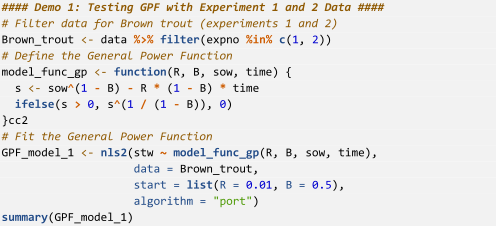
The output from the R statistical software for the general power function (Equation (1)) is summarised in Figure 1.

3.2. Example 2: Square Root Function
The estimated value of the power parameter α (B = 0.498) was close to , indicating that the square root function adequately describes the GE process in brown trout. As a result, the GE data of brown trout were reanalysed using the square root function, Equation (5), as follows:
In R statistical software, Equation (5) can be expressed as follows:

Prior to running the square root function, the initial stomach content (S0) and stomach contents at time t (St), labelled as sow and stw in the “GER_data.csv” file, need to be square-rooted as follows:

The complete R script for Equation (5) of the square root function is then integrated and executed as follows:
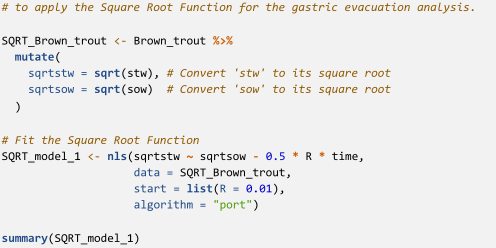
The output from the R statistical software for the square root function (Equation (5)) is summarised in Figure 2.
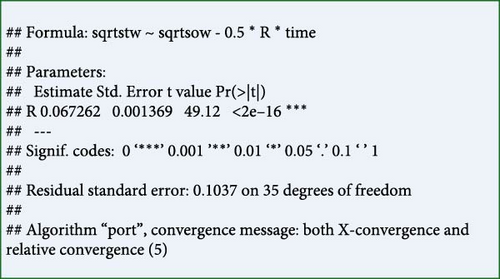
3.3. Example 3: Effects of Body Size and Temperature on GER Using General Power Function
Equation (3) of the general power function was applied to the GE experiments of brown trout [5] to identify the best-fit function for describing the pattern of GE in brown trout and to parameterise the effects of body size and temperature on GER. The parameters of Equation (3) were determined using the GE dataset of brown trout, which included both large and small fish fed on various meal sizes at water temperatures ranging from 13.0 to 19.2°C.
In R statistical software, Equation (3) of the general power function is expressed as follows:

The complete R script for Equation (3) of the general power function was integrated and executed as follows:
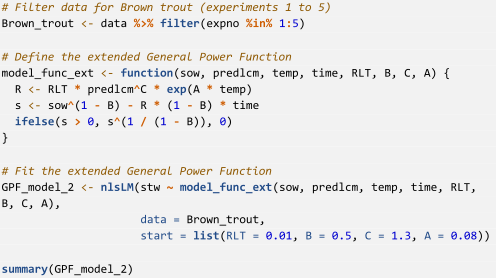
The output produced by R statistical software based on the code representing the general power function (Equation (3)) is shown in Figure 3.
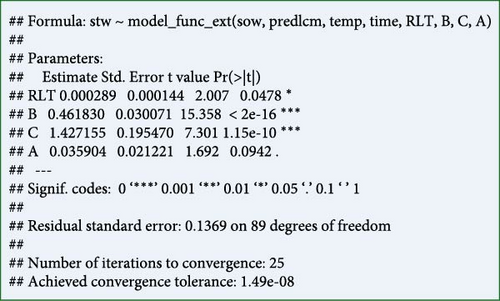
3.4. Example 4: Effects of Body Size and Temperature on GER Using the Square Root Function
The estimated value of the power parameter α (B = 0.462) in Equation (3) of the general power function reaffirmed the suitability of the square root function for GE data from brown trout. Subsequently, the effects of temperature and body size on the GER of brown trout were reanalysed using Equation (7) of the square root function.
In R statistical software, Equation (7) of the square root function is expressed as follows:

The complete R script for Equation (7) of the square root function was integrated and executed as follows:
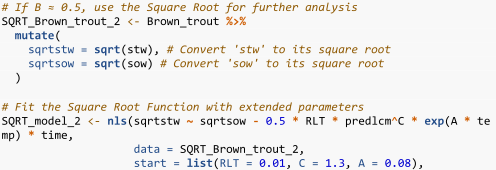

The output generated by R statistical software for the square root function (Equation (7)) is summarised in Figure 4.
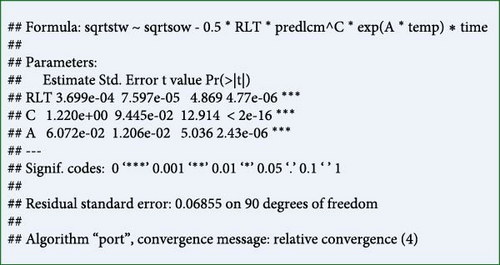
In Equations (3) and (7), the effects of water temperature on the GER of brown trout were modelled using a simple exponential function, as Dürrani and Seyhan [5] did not observe an optimum temperature for this fish within the tested range of 13.0 to 19.2°C. Consequently, the dataset for rainbow trout [6] was used to execute Equations (4) and (8), as an optimum temperature for this species has been reported.
3.5. Example 5: Optimum and Upper Thermal Limits Modelling With a General Power Function
The GE data for rainbow trout [6], which included fish of various sizes fed different meal sizes composed of commercial pellets at water temperatures ranging from 7.8 to 19.2°C, were used to determine the parameters of the general power function. This analysis incorporated the temperature function proposed by Andersen [38].
In R statistical software, Equation (4) of the general power function is expressed as follows:

Complete R script for Equation (4) of the general power function, incorporating Andersen’s [38] temperature function, was integrated and executed.
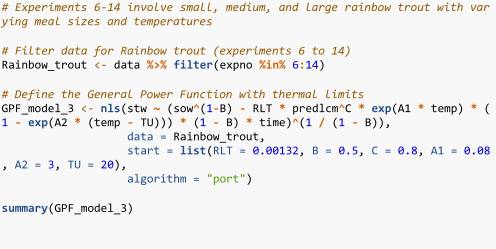
The output generated by R statistical software for the general power function (Equation (4)) is summarised in Figure 5.
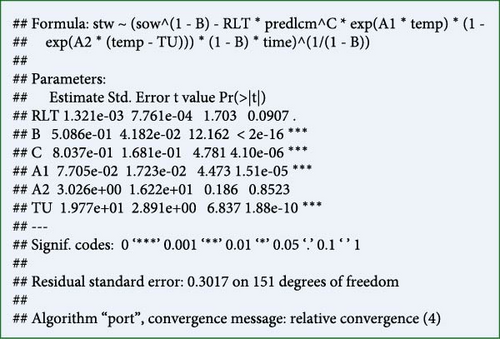
3.6. Example 6: Optimum and Upper Thermal Limits Modelling With the Square Root Function
The estimated value of the power parameter α (B = 0.509) was close to , which suggests that the square root function also best describes the GE process in rainbow trout. Consequently, the GE data for rainbow trout were reanalysed using Equation (8) of the square root function, incorporating Andersen’s [38] temperature function.
In R statistical software, Equation (8) of the square root function, incorporating Andersen’s [38] temperature function, is represented as follows:

The complete R script for Equation (8) representing the square root function was integrated and executed as follows:
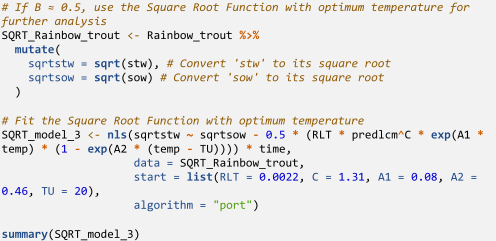
The output generated by R statistical software for the square root function (Equation (8)) is summarised in Figure 6.

Dürrani [6] fixed the value of the first temperature coefficient, δ1 (denoted as A1 in the R script), at 0.08. The corresponding results generated by R statistical software are presented in Figure 7. For further details on fixing the temperature coefficient at 0.08, refer to Andersen [38].
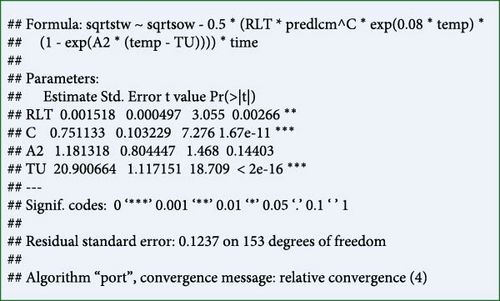
This parametrised GER model was used to determine the optimum and upper thermal limits for the GER of rainbow trout. The model demonstrates an exponential increase in GER with rising temperature, peaking at 18.6°C, with an evacuation rate parameter of 6.285 × 10−3. However, as the temperature exceeded 18.6°C, the GER declined sharply, eventually reaching zero at 20.9°C, indicating the complete cessation of GE.
3.7. Example 7: Constructing XY Plots Indicating the Optimum and Upper Thermal Limits
In this example, the length exponent λ is fixed at 0.75 in Equation (6) of the square root function, which is expressed as .
This equation was used to estimate the rate parameter constant ρL for each individual GE experiment conducted on the rainbow trout, as summarised in Figure 8.
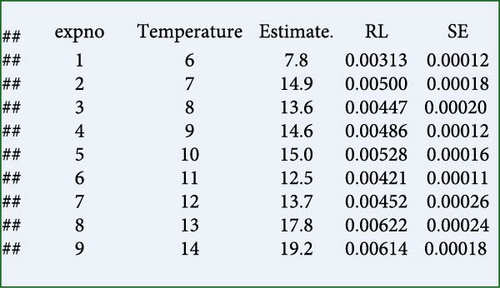
In R statistical software, Equation (6) of the square root function is expressed as follows:

The rate parameter constant ρL for each individual experiment indicates an increase in the GER from 3.13 × 10−3 at 7.8°C to 5.28 × 10−3 at 15°C (Figure 8). Subsequently, Equation (7), , is applied to determine the effects of temperature within the lower range, covering experiments 6–11 (Figure 9). It should be noted that this step is optional and is not necessary to determine the optimum and upper temperature limits; it serves only as an illustration. The exponential function predicts a continuous increase in GER with increasing temperature, which is physiologically implausible.
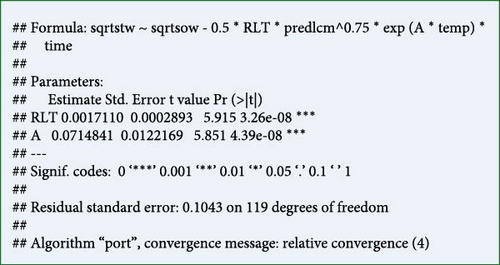
The rate parameter constant ρL for each individual experiment was plotted against the temperature and two curves were provided: the exponential curve (- - - - -) is provided by the use of ρL = 0.00171e0.072T, while the optimum temperature curves (—) are provided by the use of ρLT = 0.00152e0.08T(1 − e1.18(T − 20.90)) (Figure 10).
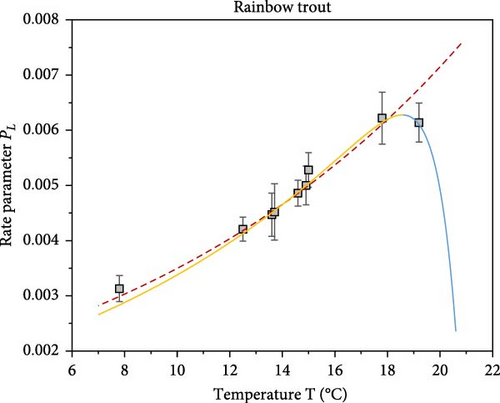
3.8. Example 8: Constructing XY Plots With GE Curves Using a Parametrised GER Model
In this example, the parameterised GER models for brown trout (Equation (9)) and rainbow trout (Equation (11)) are used to generate GE curves for individual GE experiments, demonstrating the procedure in an Excel sheet.
Equation (9) was used to generate the GE curve for brown trout, with fish averaging 30 cm in total length fed a 6 g meal of commercial pellets at 17.5°C (Figure 11a). Similarly, Equation (11) was applied to rainbow trout, in which fish of the same length received 7 g of meal at 19.2°C (Figure 11b).

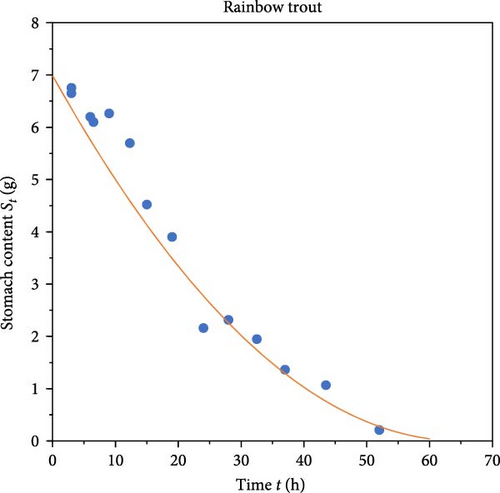
To illustrate the GE process, the weight of stomach contents (g) recovered at various postprandial times t is plotted on the Y-axis, while the corresponding recovery time t is plotted on the X-axis. The parametrised GER model is then used to generate the GE curve, depicting the relationship between stomach contents (g) and the elapsed time t. This visualisation effectively demonstrates how stomach contents decrease over time as the fish digests its meal. The GE curve, which was derived from the parametrised GER model, provides valuable insights into the digestion process by clarifying the rate at which the stomach evacuates its contents.
4. Discussion
This study presents the first comprehensive guide for analysing GE data using the general power function in R statistical software. A key advantage of the R statistical software’s nls function lies in its flexibility for accommodating diverse models, enhancing its applicability across datasets [41, 42]. Reanalysis of GE data from brown trout [5] and rainbow trout [6] using this software reaffirmed the superior fit of the square root function, which accurately describes the course of GE independently of meal size. The square root model’s utility has been validated for multiple wild fish species, including saithe (Pollachius virens Linnaeus, 1758), whiting (Merlangius merlangus Linnaeus, 1758) and Atlantic cod, which were fed a variety of prey species [3, 22, 36, 50, 51]. Similarly, this function has proven effective in describing GE in farmed fish species such as brook trout, brown trout, rainbow trout and European seabass (Dicentrarchus labrax Linnaeus, 1758) [5, 6, 52, 53]. Furthermore, the square root function is supported by the mechanistic cylinder model, which considers surface area digestion, although meal characteristics—discussed in the Introduction section—can cause deviations that should be considered when modelling GE in predatory fish. Thus, various studies have provided strong empirical support for the application of the square root function to model GER in both farmed and wild fish.
Notably, the temperature coefficient, particularly in the optimum temperature function (δ2) was not statistically significant (Figures 5–7). This lack of significance likely arises from two interrelated factors. First, the dataset is imbalanced with respect to body size and temperature, which increases variability in specific subgroups and diminishes the function’s capacity to detect a true temperature effect. Second, the narrow gap between the two highest temperature groups may mask subtle changes in GER, as the physiological response appears to plateau near the upper temperature limit. These findings are consistent with Andersen [38], who observed similar issues even with balanced data when the upper temperature range was limited. Future research should consider expanding the temperature range and addressing data imbalances to more accurately capture the temperature-dependent behaviour of GE.
The general power function offers a promising approach for modelling GE and may have potential applications beyond fish, extending to other animal species. Future studies should explore this possibility to evaluate its broader relevance in digestive physiology. If empirical data from non-fish species indicate functions other than the square root, researchers should readily adjust parameters in the R script to transition between the functions (Figure 12). Consequently, the ability to transition between functions and integrate additional predictors should enable researchers to model diverse GE processes. For example, Equation (8) can be extended to parameterise the effect of dietary energy on GER:

In R statistical software, this equation can be expressed as follows:

Although the general power function provides a robust statistical framework, stage-dependent mechanistic approaches rooted in the basic square root function, such as the method applied by Andersen, Chabot, and Couturier [50] to model crustacean prey evacuation, are strongly recommended over transitioning between functions. This approach can address inherent limitations of purely statistical methods, that is, Couturier et al. [37], which may oversimplify physiological processes, particularly in prey species with distinct digestion phases. Although a full exploration of mechanistic models falls outside the scope of this study, their utility for capturing biological realism in complex systems is emphasised.
Additionally, established statistical software conversion tools (e.g., CodeConvert AI: www.codeconvert.ai) enable efficient translation of R scripts into formats compatible with other widely used statistical platforms, such as SAS or Python. This capability ensures that methodologies developed in R can be readily adapted and implemented across alternative software environments, thereby, enhancing the accessibility and applicability of this study.
5. Conclusions
This study offers a practical guide to modelling GER in fish using the general power function, with a particular emphasis on parameter estimation and analysis using R statistical software. This approach should simplify and enhance the efficiency of the GER modelling process. The results suggest that the general power function provides a robust and versatile framework for GER modelling, with applications across diverse statistical environments. This methodology can advance research on GE while also deepening our understanding of digestive efficiency and metabolic responses in fish. Furthermore, these findings are expected to provide a solid foundation for future research, enabling the exploration of GER across various species and environmental conditions, which could drive further progress in the field.
Conflicts of Interest
The author declares no conflicts of interest.
Funding
The author declare that no funds, grants or other support were received for this study.
Open Research
Data Availability Statement
The R script and sample dataset (gastric evacuation data) used in this study are available in the GitHub repository: https://github.com/OmerhanDurrani/Modelling_GER. This repository also includes a detailed procedure for constructing Figures 10 and 11, provided in Microsoft Excel format.




